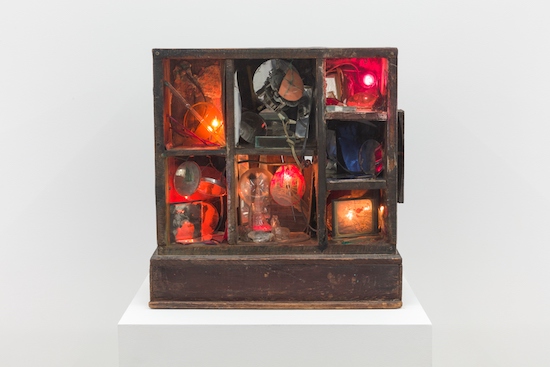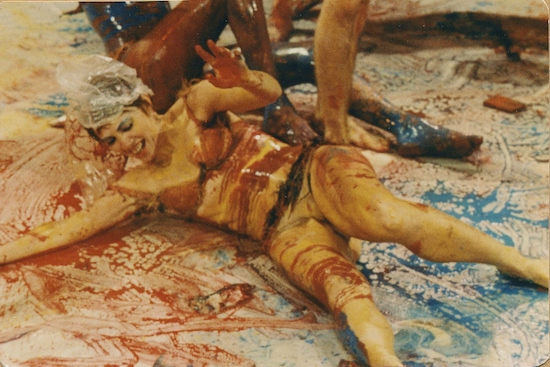Carolee Schneemann Meat Joy,16–18 November 1964 Judson Dance Theater, Judson Memorial Church, New York
Photograph by Robert McElroy Courtesy of the Carolee Schneemann Foundation and Galerie Lelong & Co., Hales Gallery, and P.P.O.W, New York and © Carolee Schneemann Foundation / ARS, New York and
DACS, London 2022 Photograph © 2022 Estate of Robert R. McElroy / Licensed by VAGA at Artists Rights Society
Like many people in the UK interested in contemporary art I’ve only known about Carolee Schneemann’s work through historical texts and grainy photographic images of performances like Interior Scroll (1975) and Meat Joy (1964). Didn’t the Fire Engines rip off the latter for their Big Gold Dream sleeve cover back in 1981? And wasn’t it the Coen brothers who parodied Schneemann’s Up to and Including Her Limits (1976) with Maud, the ‘strongly vaginal’ artist played by Julianne Moore, doing similar stunts by painting and drawing in a swinging harness, in The Big Lebowski (1998)?
We should be grateful then to the Barbican art gallery for putting on this extensive posthumous retrospective that covers Schneemann’s works from 1953 to her death aged seventy-nine in 2019. There’s much that surprises here. Schneemann always saw herself as a painter and we begin with her early oils influenced by Cezanne and the American abstract expressionists of the 1950s, specifically Willem de Kooning, as with the broad sweeps of yellow and pink paint seen in Aria Duetto (Cantata No. 78): Yellow Ladies (1957). The title refers to her inspiration from the music of JS Bach. To the eye of today this looks like a Cecily Brown painting, the markings of the abstraction obscuring the nude female form. Similarly we can make out a naked male in JT and Three Kitch’s (1957), emerging from a background of Frankenthaler-like smears. An early self-portrait from 1955 proves Schneemann had the chops, had what it takes long-term, to bust through the glass ceiling of what she called ‘the Art Stud Club’ starring Pollock et al. This was critic Harold Rosenberg’s gang of male action painters that excluded the likes of Lee Krasner, Elaine de Kooning, Joan Mitchell, and, of course, Schneemann herself.
In the early 1960s Schneemann went on to construct boxes after making the acquaintance of Joseph Cornell. Hers are more explosive affairs with little of the quietly allusive qualities of the reclusive Master living on Utopia Parkway. Schneemann would sometimes drench her found materials – light bulbs, shards of mirror, straw – with turpentine or kerosene and then set this combine alight, like some deranged chef. The exploded remnants, as with Controlled Burning: Fireplace (1963–4), make up the finished work – and all this decades before Cornelia Parker’s experiments with ignition.
1963 proved to be a key transitional period in her practice. With Eye Body: 36 Transformative Actions for Camera sees Schneemann using her body “as an extension of my painting”. Here she covered her body with paint, made gestures with shards of glass, grass snakes, and cow skulls, then had the lot photographed. These still look confrontational, intense, scary. By this time she was in with the choreography crowd of the Judson Dance Theatre and the burgeoning Happenings scene. She dug that old phony Wilhelm Reich. Her intentions? To again “threaten the psychic territorial power lines by which women were admitted to the Art Stud Club so long as they behaved enough like the man, did work clearly in the traditions and pathways hacked out by the men”. They heard her knocking but they wouldn’t let her in. Some critics thought her work lewd. How to respond? Schneemann upped the ante.
There was the anarchic performance Newspaper Event (1963) with people rolling round on a carpet of old newsprint, a crazed scene reinvented by Dash Snow and Dan Colen’s ‘nests’ in the early 2000s. And not long after this, Meat Joy comes in: Schneemann called it an ‘erotic rite’, a ‘flesh jubilation’. Stills from the event make it look like a semi-nudie version of the Beatles banned cover for Yesterday and Today, with folks covered in paint and raw fish, chicken and sausages, pulling and pawing at one another; ‘From Me to You’ was playing in the background. Also heard: Dusty Springfield, Elvis, The Supremes, and Dionne Warwick singing ‘Anyone Who Had A Heart.’ It looks orgiastic, utterly Dionysian.
Schneemann performed Meat Joy at the Roundhouse, London, in 1967 and stayed in the city from 1969–1973. She kept up her confrontational art and pissed off a “red jowled General” at the ICA. She wanted them to show Fuses (1964–67), a film collage of her and James Tenney, her partner, having sex. This work challenged the male gaze, was explicitly against women portrayed as sexual objects, and aimed for a higher, more poetic and sensual imagery of intimacy. You can see its (assumed) influence on Nic Roeg and his scenes of sexual pleasure and love between Julie Christie and Donald Sutherland in Don’t Look Now (1973).
1972 saw her on a high-speed train from London to Edinburgh performing Ices Strip/Isis Trip. Schneemann took over the dining car where there was a buffet of “purple bread, cold green hot dogs, black mustard, magenta spaghetti, violet pound cake, and blue milk”. Yummy. She got up on a table, performed a strip tease, and read (ever the iconoclast) from Wittgenstein’s Tractatus Logico-Philosophicus. Then she roller-skated down the length of the train. Beat that Thameslink. It’s hard to dislike Schneemann, especially if you’re a fan of cats. One time she even argued that “CATS ARE MY MEDIUM”. She made a photographic series called Infinity Kisses (1981–87) that saw her planting smackers on Cluny, her pet of the time.

Carolee Schneemann, Pharaoh’s Daughter, 1966, Wooden box, lightbulbs, slides, oil paint, clock, ampule, metallic objects, paper and mirrors 50.8 × 49.5 × 25.4 cm Private collection, London
© Carolee Schneemann Foundation / ARS, New York and DACS, London 2022 Photograph by JSP Art Photography
On to more serious matters: Interior Scroll saw her attacking patriarchal stereotypes by pulling a long roll of paper from her vagina and reading its text warning women to “be prepared” for sexist mistreatment, distortion and discrimination. Then there was her works on war. The show here at the Barbican is on two levels and the ground floor features Schneemann’s collaged films that have a more direct take on the body under attack, specifically those affected by war. Viet-Flakes (1962–67) may well be the first artwork to address the atrocities perpetrated by the US in South-East Asia. The traumas mount up in The Lebanon Series (1981-89) where she hones in, yet again, on male violence during the country’s civil war.
The show ends with more damage done to the body. We see the falling people from the collapsing Twin Towers in Terminal Velocity (2001–5). Finally, there’s a work that addresses Schneemann’s own frailty: Known/Unknown: Plague Column (1995), a work about her cancer and how we deal with oncology. It’s a troubling work, another meditation on Schneemann’s fascination with transformation, with its images of malignant cells and plague memorials. There’s also some real oranges pierced with syringes that may or may not refer to the pathological sign peau d’orange, seen with some breast tumours.
In short, there’s a lot to take in here but get along if you can. And it’s worth adding that the detailed catalogue (published by Yale) with its essays and explications is quite superb.
Carolee Schneemann: Body Politics is at the Barbican until 8 January 2023


